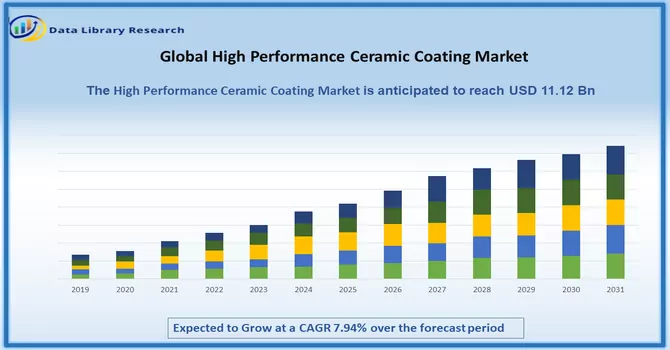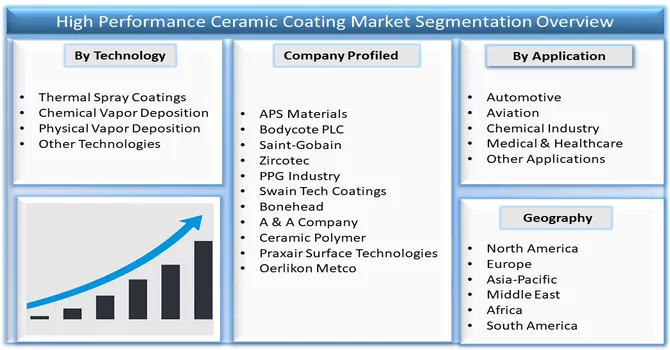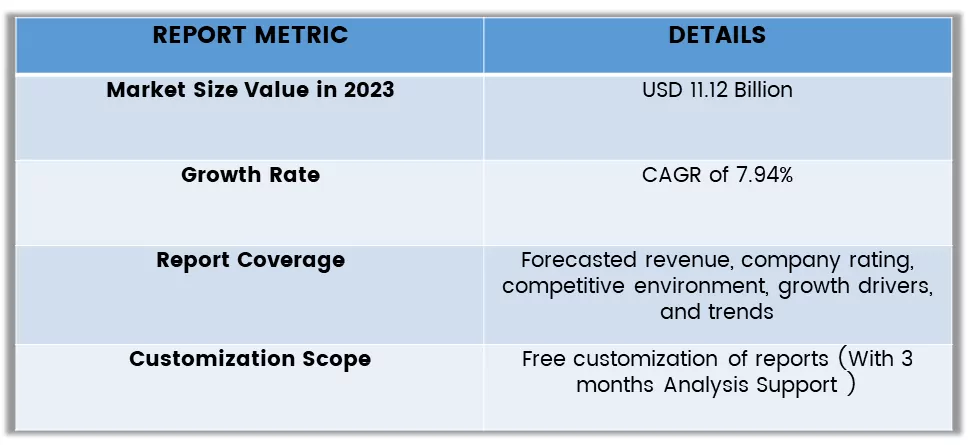The high-performance ceramic coatings market is estimated to reach a value of USD 11.12 billion in the year 2023 and is expected to grow at a compound annual growth rate of 7.94% for the forecast period of 2024 to 2031.

Get Complete Analysis Of The Report - Download Free Sample PDF
High-Performance Ceramic Coatings are advanced coatings applied to surfaces to enhance their properties such as wear resistance, corrosion resistance, and thermal protection. These coatings are typically made from ceramics, which are inorganic, non-metallic materials that exhibit high hardness, excellent thermal stability, and good chemical resistance. These coatings are used in various industries such as aerospace, automotive, electronics, and energy, where high performance and durability are required. High-performance ceramic coatings can improve the lifespan and performance of components, reduce maintenance costs, and enhance overall efficiency.
The growth of the Performance Ceramic Coatings market is fueled by a combination of factors that underscore the increasing importance and versatility of these coatings. Industries such as automotive, aerospace, and healthcare are increasingly turning to Performance Ceramic Coatings due to their exceptional properties. These coatings offer high-temperature resistance, corrosion resistance, and wear resistance, making them ideal for a wide range of applications. In the automotive and aerospace sectors, there is a growing emphasis on fuel efficiency and lightweight materials. Performance Ceramic Coatings helps in achieving these goals by reducing the weight of components without compromising on performance. Similarly, in the healthcare industry, these coatings are in high demand for medical implants due to their biocompatibility and wear resistance. Technological advancements in coating technologies are also driving market growth. Ongoing research and development efforts have led to the development of innovative coatings, such as nanocomposite coatings, which offer enhanced properties and performance. Additionally, improved deposition techniques have made it easier to apply these coatings to a variety of surfaces, further expanding their potential applications. Stringent environmental regulations regarding emissions and waste disposal are also playing a role in driving market growth. Performance Ceramic Coatings are more environmentally friendly compared to traditional coatings, making them a preferred choice for industries looking to reduce their environmental impact. Furthermore, the increasing infrastructure development in emerging economies is driving demand for Performance Ceramic Coatings for use in buildings, bridges, and other structures. Overall, these factors are contributing to a positive outlook for the Performance Ceramic Coatings market, with continued growth expected in the coming years.
Market Segmentation: The High-performance Ceramic Coatings Market is Segmented By (Thermal Spray Coatings, Chemical Vapor Deposition, Physical Vapor Deposition, and Other Technologies), Application (Automotive, Aviation, Chemical Industry, Medical & Healthcare, and Other Applications) and Geography (North America, Europe, Asia-Pacific, Middle-East and Africa, and South America). The market provides the value (in USD million) for the above segments.

For Detailed Market Segmentation - Download Free Sample PDF
The High-Performance Ceramic Coatings market is witnessing several key trends, including growing demand from the automotive industry for fuel efficiency and lightweight solutions, driving the adoption of these coatings. Environmental sustainability concerns are also fueling growth as these coatings offer eco-friendly alternatives. Advancements in coating technologies, particularly in nanocomposite coatings, are leading to improved performance and durability. Aerospace, defence, and healthcare sectors are increasingly using these coatings for their protective and biocompatible properties. Additionally, companies are focusing on research and development to innovate and meet the evolving demands of various industries, indicating a positive growth trajectory for the market.
Market Drivers:
Increasing Demand from End-Use Industries
The High-Performance Ceramic Coatings market is experiencing increasing demand from a wide range of end-use industries, driving significant growth. Industries such as automotive, aerospace, healthcare, electronics, and energy are increasingly turning to high-performance ceramic coatings to enhance the durability, performance, and lifespan of their products and components. In the automotive industry, these coatings are used to improve fuel efficiency, reduce emissions, and enhance the aesthetics of vehicles. The aerospace industry utilizes high-performance ceramic coatings to protect critical components from high temperatures, corrosion, and wear, thereby improving the performance and longevity of aircraft and spacecraft. The healthcare sector relies on these coatings for medical implants and devices due to their biocompatibility, wear resistance, and corrosion resistance. In the electronics industry, high-performance ceramic coatings are used to protect components from harsh environments and improve their performance and reliability. The energy sector utilizes these coatings in various applications, including turbine engines, solar panels, and oil and gas equipment, to improve efficiency and durability. Thus, the increasing demand from these end-use industries is expected to drive significant growth in the High-Performance Ceramic Coatings market in the coming years, as companies continue to seek ways to enhance the performance and longevity of their products.
Rising Demand for Medical Implants
The rising demand for medical implants is a significant driver for the High-Performance Ceramic Coatings market. High-Performance Ceramic Coatings are increasingly being used in medical implants due to their biocompatibility, wear resistance, and corrosion resistance. These coatings enhance the performance and lifespan of medical implants, making them more reliable and durable for patients. In the healthcare sector, High Performance Ceramic Coatings are used in a variety of medical implants, including dental implants, joint replacements, and cardiovascular implants. These coatings help improve the biocompatibility of the implants, reducing the risk of rejection and improving the overall success rate of the procedures. The increasing demand for medical implants is being driven by several factors, including an ageing population, the rising prevalence of chronic diseases, and advancements in medical technology. As the demand for medical implants continues to grow, the High-Performance Ceramic Coatings market is expected to expand as well, providing significant opportunities for manufacturers and suppliers in the healthcare sector. Thus, the rising demand for medical implants is expected to be a key driver for the High Performance Ceramic Coatings market in the coming years, as the healthcare industry continues to seek innovative solutions to improve patient outcomes and quality of life.
The COVID-19 pandemic initially led to a decline in the High-Performance Ceramic Coatings market due to disruptions in manufacturing and reduced consumer spending. Industries like automotive and aerospace, key consumers of these coatings, experienced slowdowns. However, as the world recovers, the market is expected to rebound. The focus on hygiene and safety measures is driving demand in industries like healthcare and food processing, while the trend towards lightweight materials in automotive and aerospace is creating opportunities. Despite short-term challenges, the long-term outlook for the market remains positive.
Segmental Analysis:
Thermal Spray Coatings Segment is Expected to Witness Significant Growth Over the Forecast Period
Thermal spray coatings play a crucial role in the High-Performance Ceramic Coatings market, offering a versatile and cost-effective solution for enhancing the properties of various substrates. Thermal spray processes, such as plasma spraying, HVOF (High-Velocity Oxygen Fuel), and flame spraying, are commonly used to apply ceramic coatings to surfaces, providing them with enhanced wear resistance, corrosion resistance, thermal insulation, and electrical insulation properties. The High Performance Ceramic Coatings market benefits significantly from the use of thermal spray coatings, particularly in industries such as aerospace, automotive, and energy, where high-performance coatings are essential for improving component durability and performance. Thermal spray coatings can be applied to a wide range of substrates, including metals, ceramics, and composites, making them ideal for use in diverse applications. In the aerospace industry, thermal spray coatings are used to protect components from high temperatures, corrosion, and wear, thereby improving the performance and lifespan of aircraft engines and structures. In the automotive industry, thermal spray coatings are used to enhance the durability of engine components, such as pistons and cylinders, as well as to improve fuel efficiency and reduce emissions. Thus the use of thermal spray coatings is expected to drive growth in the High Performance Ceramic Coatings market, as industries continue to seek innovative solutions for improving the performance and longevity of their products.
Automotive Segment is Expected to Witness Significant Growth Over the Forecast Period
The automotive industry is a key driver for the High-Performance Ceramic Coatings market, with a wide range of applications that benefit from the unique properties of these coatings. High-Performance Ceramic Coatings are used in the automotive sector to improve the performance, durability, and aesthetics of vehicles. One of the primary applications of High-Performance Ceramic Coatings in the automotive industry is in engine components. These coatings are used to improve the efficiency of engines by reducing friction and wear on components such as pistons, cylinders, and bearings. By reducing friction, these coatings can help improve fuel efficiency and reduce emissions, making them an attractive option for automakers looking to meet stringent environmental regulations. High-Performance Ceramic Coatings are also used in the automotive industry to protect exterior surfaces from corrosion, abrasion, and UV radiation. These coatings can help maintain the appearance of vehicles and protect them from environmental damage, thereby extending their lifespan and enhancing their resale value. Additionally, High-Performance Ceramic Coatings are used in the automotive industry to enhance the performance of braking systems. These coatings can improve the thermal stability of brake components, reducing the risk of brake fade and improving overall braking performance. Thus, the automotive industry's continued demand for High-Performance Ceramic Coatings is expected to drive growth in the market, as automakers look for ways to improve the performance, durability, and efficiency of their vehicles.
North America Region is Expected to Witness Significant Growth Over the Forecast Period
North America is a significant region for the High-Performance Ceramic Coatings market, driven by various factors such as technological advancements, stringent regulations, and a strong presence of key end-use industries. The region is home to several major players in the ceramics and coatings industries, leading to a high level of innovation and product development in the market. In North America, the automotive industry is a major consumer of High-Performance Ceramic Coatings, with a focus on improving fuel efficiency, reducing emissions, and enhancing vehicle performance. The aerospace industry is another key market for these coatings, where they are used to protect critical components from high temperatures, corrosion, and wear. Additionally, the healthcare sector in North America is increasingly utilizing High-Performance Ceramic Coatings for medical implants and devices, owing to their biocompatibility and corrosion resistance. The electronics industry also contributes to the demand for these coatings, using them to protect components from harsh environments and improve their performance and reliability. Furthermore, North America has stringent environmental regulations, which are driving the adoption of eco-friendly coatings such as High-Performance Ceramic Coatings. This regulatory environment, coupled with the region's focus on technological advancements, is expected to continue driving growth in the High-Performance Ceramic Coatings market in North America.

Get Complete Analysis Of The Report - Download Free Sample PDF
The analyzed market exhibits a high degree of fragmentation, primarily attributable to the presence of numerous players operating on both a global and regional scale. The competitive landscape is characterized by a diverse array of companies, each contributing to the overall market dynamics. This fragmentation arises from the existence of specialized solution providers, established industry players, and emerging entrants, all vying for market share. The diversity in market participants is underscored by the adoption of various strategies aimed at expanding the company presence. On a global scale, companies within the studied market are strategically positioning themselves through aggressive expansion initiatives. This often involves entering new geographical regions, targeting untapped markets, and establishing a robust global footprint. The pursuit of global expansion is driven by the recognition of diverse market opportunities and the desire to capitalize on emerging trends and demands across different regions. Simultaneously, at the regional level, companies are tailoring their approaches to align with local market dynamics. Regional players are leveraging their understanding of specific market nuances, regulatory environments, and consumer preferences to gain a competitive edge. This regional focus allows companies to cater to the unique needs of local clientele, fostering stronger market penetration. To navigate the complexities of the fragmented market, companies are implementing a range of strategies. These strategies include investments in research and development to stay at the forefront of technological advancements, mergers and acquisitions to consolidate market share, strategic partnerships for synergies, and innovation to differentiate products and services. The adoption of such multifaceted strategies reflects the competitive nature of the market, with participants continually seeking avenues for growth and sustainability. In essence, the high fragmentation in the studied market not only signifies the diversity of players but also underscores the dynamism and competitiveness that drive ongoing strategic manoeuvres. As companies explore various avenues for expansion, the market continues to evolve, presenting both challenges and opportunities for industry stakeholders.
Major Companies in the Market Include:
Recent Development:
1) In June 2022, a study investigated the use of nickel-coated carbon nanotubes as an electrolyte additive in preparing microarc oxidation ceramic coatings on ZL109 aluminium alloy. Different concentrations of nickel-coated carbon nanotubes were added to the electrolyte, altering the morphology of the coatings. The coating prepared with 1.2 g/L of nickel-coated carbon nanotubes showed excellent wear resistance. This research contributes to the high-performance ceramic coating market by offering a novel approach to improving coating properties, particularly for lightweight equipment in industries like automotive and aerospace.
2) In 2021, The underperformance of metallic biomaterials in orthopaedic implants, due to issues like inadequate bio-functionality, high degradation rates, and implant-associated infections leading to failure, highlights the need for surface modifications without compromising mechanical properties. Bio-ceramic coatings offer a promising solution by enhancing the bio-functionality of metallic surfaces. Silicate-based ceramic coatings, known for their chemical stability and ionic dissolution products, have shown great potential in orthopaedic applications. This study reviewed various silicate-based coatings and their methods of preparation, demonstrating their ability to improve osseointegration and prevent bacterial biofilm formation on metallic substrates. Incorporating such coatings could significantly enhance the lifetime stability and performance of metallic implants, addressing key challenges in the orthopaedic industry.
Q1. What was the High Performance Ceramic Coating Market size in 2023?
As per Data Library Research the high-performance ceramic coatings market is estimated to reach a value of USD 11.12 billion in the year 2023.
Q2. At what CAGR is the High Performance Ceramic Coating market projected to grow within the forecast period?
High Performance Ceramic Coating Market is expected to grow at a compound annual growth rate of 7.94% for the forecast period.
Q3. What segments are covered in the High Performance Ceramic Coating Market Report?
By Type, By Application & Geography these segments are covered in the High Performance Ceramic Coating Market Report.
Q4. What are the factors driving the High Performance Ceramic Coating market?
Key factors that are driving the growth include the Increasing Demand from End-Use Industries and Rising Demand for Medical Implants.
Data Library Research are conducted by industry experts who offer insight on industry structure, market segmentations technology assessment and competitive landscape (CL), and penetration, as well as on emerging trends. Their analysis is based on primary interviews (~ 80%) and secondary research (~ 20%) as well as years of professional expertise in their respective industries. Adding to this, by analysing historical trends and current market positions, our analysts predict where the market will be headed for the next five years. Furthermore, the varying trends of segment & categories geographically presented are also studied and the estimated based on the primary & secondary research.
In this particular report from the supply side Data Library Research has conducted primary surveys (interviews) with the key level executives (VP, CEO’s, Marketing Director, Business Development Manager and SOFT) of the companies that active & prominent as well as the midsized organization
FIGURE 1: DLR RESEARH PROCESS

Extensive primary research was conducted to gain a deeper insight of the market and industry performance. The analysis is based on both primary and secondary research as well as years of professional expertise in the respective industries.
In addition to analysing current and historical trends, our analysts predict where the market is headed over the next five years.
It varies by segment for these categories geographically presented in the list of market tables. Speaking about this particular report we have conducted primary surveys (interviews) with the key level executives (VP, CEO’s, Marketing Director, Business Development Manager and many more) of the major players active in the market.
Secondary ResearchSecondary research was mainly used to collect and identify information useful for the extensive, technical, market-oriented, and Friend’s study of the Global Extra Neutral Alcohol. It was also used to obtain key information about major players, market classification and segmentation according to the industry trends, geographical markets, and developments related to the market and technology perspectives. For this study, analysts have gathered information from various credible sources, such as annual reports, sec filings, journals, white papers, SOFT presentations, and company web sites.
Market Size EstimationBoth, top-down and bottom-up approaches were used to estimate and validate the size of the Global market and to estimate the size of various other dependent submarkets in the overall Extra Neutral Alcohol. The key players in the market were identified through secondary research and their market contributions in the respective geographies were determined through primary and secondary research.
Forecast Model
